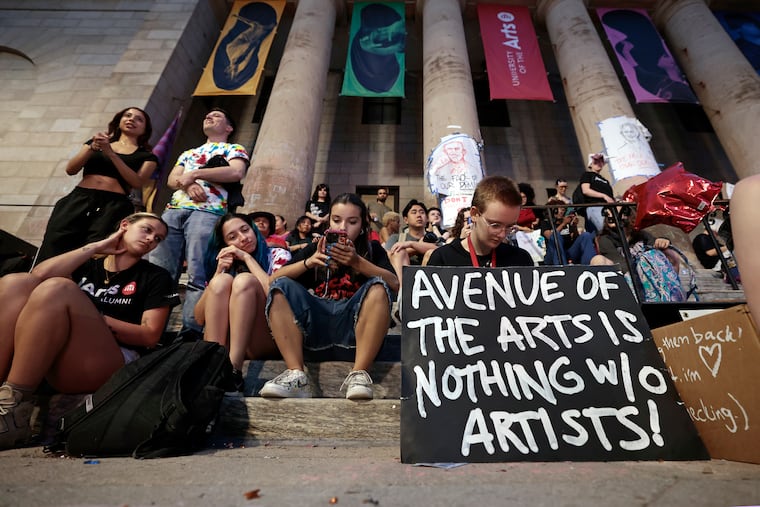University of the Arts’ dance program is moving to Vermont
The rescue from comes just two months after UArts’ abrupt closure

The University of the Arts has been thrown a lifeline from Bennington College, the small liberal arts school in Bennington, Vt., which will take over at least one part of the defunct school: UArts’ well-regarded dance program.
Described as a “union” in a Thursday announcement from Bennington College, the new undergraduate and graduate dance program will operate at Bennington’s campus for the coming school year, and is expected to return to Philadelphia in the fall of 2025.
The name, exact Philadelphia location, and other aspects of the new dance program are yet to be worked out. But one aspect of it remains firm. The program will continue to draw its identity and faculty from the city.
“We couldn’t do the school without Philadelphia,” said Donna Faye Burchfield, the former dean of dance at the University of the Arts who is heading the Bennington program. “Philadelphia is the reason the school thrives. This city and all its complexities and all its vibrancy and histories are woven into the faculty who teach there, the history of the school.”
Bennington College president Laura R. Walker said that while the future of the dance program in Philadelphia was contingent upon raising the money, the school was committed to the idea.
“We’re going to evolve it as we go, but our intention is to take this on,” said Walker. “We are investing in a person [Burchfield] and a faculty, and a program that’s going to have a life and have roots in Philadelphia.”
It was unclear whether Bennington’s rescue of the dance program might affect Temple University’s potential interest in a merger with the University of the Arts. A Temple spokesperson on Friday did not address that question or answer a question about the status of exploratory talks.
The University of the Arts, which traced its roots back nearly a century and a half, closed June 7 on just a week’s notice and without explanation.
Of the new dance program, Walker said that while details aren’t yet developed, she envisions Bennington students sharing in resources like faculty and master class guest artists, and perhaps even students in disciplines other than dance coming to Philadelphia to take advantage of the city and its resources.
“We see it very much as an extension of what Bennington is,” said Walker, citing the school’s central placement of the arts in the life of its students.
She also held out the possibility that Bennington could take on relationships with other arts programs that were once a part of the University of the Arts. The school had programs in a wide variety of disciplines, including music, theater, visual arts, film, and product design.
“We would certainly be open to talking about it,” Walker said.
The new dance program at Bennington will be more modest than the University of the Arts’ dance program. UArts had been expecting 127 new and continuing students in its bachelor of fine arts program this fall, said Burchfield. Only 35 will be going to Bennington. UArts employed 11 full-time dance faculty members. The new Bennington program — which includes both a bachelor’s and master’s of fine arts in dance — will have no full-time faculty, but a roster of part-timers and visiting artists. A total of 28 low-residency MFA students are expected.
Bennington already offers dance classes, but the UArts dance program is not being absorbed by the dance department there. The two programs will exist side by side, each with a different focus. Bennington students “create their own path through varied disciplines, of which dance could be a part,” said Burchfield. Students enrolled in the new Bennington-UArts dance program “are studio-based artists who have their minds focused on being professional dance artists,” she said.
It was Burchfield who approached Bennington College with the idea after the University of the Arts’ closure was revealed with just a week’s notice. “I just started making phone calls because I couldn’t accept the news,” she said. She brainstormed with Sean Buffington, who left the leadership of the University of the Arts a decade ago, on a list of possible institutions that could step in, and Bennington was on it.
In a first call with Walker, “she was really welcoming and generous,” said Burchfield, “and she said to me, ‘Explain to me again what you’re trying to do. And I was like, ‘Well, I’m trying to save our school.’”
Burchfield said a potential role for Temple University never came up in her quest to salvage the UArts dance program.
“To be honest, I couldn’t wait. I never was involved in conversations about Temple and our school of dance.”
Bennington was an interested partner for a variety of reasons, Walker said. The arts are central to the school’s student experience and curriculum, she said, and she was eager to participate in an innovative solution to a crisis. She said she was thinking back to a recent conversation she had with Darren Walker (no relation), president of the Ford Foundation, which is helping fund the transition of UArts’ dance program with a $250,000 grant.
“I think we all, in the arts and higher education, need to be thinking of different models and partnerships, because there are too many schools closing. We need to work together for the sake of the students and for the sake of the arts in higher education,” Laura R. Walker said. “The arts are the expression of the diversity of our world, of the human condition, of the struggle and the joys. And it’s going to help us through this time we’re in. We have to embrace it and we have to do it differently, and we have to figure out ways to move swiftly and nimbly.”